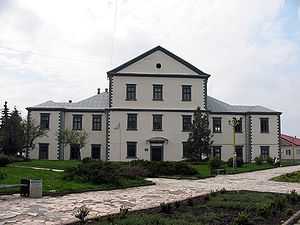House of Zamoyski


Zamojski, plural: Zamojscy is the surname of an important Polish nobility (szlachta) family of Jelita coat of arms. The name is sometimes spelled Zamoyski. It is the Polish for "de Zamość" (Polish "z Zamość"), the name they originally held as lords of Zamość. The family was influential in Polish politics for several centuries, and its members held various official titles, including those of Count and Countess.
Family history
The family traces its origins to the Łaźiński family. In the 15th century Tomasz Łaźiński bought an estate in Stary (Old) Zamość. His sons Florian (died 1510) and Maciej assumed the name Zamojski. The family begun to raise in prominence. Florian’s grandson Stanisław was the castellan of Chełm, and his son, Jan Zamojski, arguably the most famous member of the family, became a chancellor, hetman, and founded the Zamojski's Ordynat - a large estate that was a major source of the family's wealth. He was the 1st Ordynat of the Zamoyski family. His son, Tomasz Zamojski, the 2nd Ordynat, was also a chancellor in Poland. Many of their descendants held important positions within the Polish-Lithuanian Commonwealth, often that of a voivode.
In the 18th century, the 10th Ordynat, Andrzej Zamoyski, became the third chancellor of Poland in the family's history. He was one of the authors of a plan for general reform of the nation, known as Zamoyski Code. The family received the title of count from the Holy Roman Emperor in the late 18th century. Brothers Andrzej Artur Zamoyski and Władysław Stanisław Zamoyski, supported Polish movements aimed at regaining independence during the partitions period; Władysław was exiled after participating in the November Uprising, and Andrzej, in the aftermath of the January Uprising.
Andrzej's grandson, Maurycy Zamoyski, was a Minister of Foreign Affairs in the Second Polish Republic for seven months in 1924.
Notable members
- Jan Zamoyski (1542–1605), Great Crown Chancellor and Great Crown Hetman
- Tomasz Zamoyski (1594–1638), Deputy Chancellor of the Crown
- Gryzelda Konstancja Zamoyska (1623–1672), mother of King Michał Korybut Wiśniowiecki.
- Jan "Sobiepan" Zamoyski (1627–1662), magnate, voivode
- Andrzej Zamoyski (1716–1792), Great Crown Chancellor, humanist and reformer
- Władysław Stanisław Zamoyski (1803–1868), politician, general, activist of Hôtel Lambert
- Andrzej Artur Zamoyski (1800–1874), political and economic activist
- Maurycy Zamoyski (1871–1939), Minister of Foreign Affairs of Poland
- Andrzej Przemysław Zamoyski (1852-1927), landowner, married to Princess Maria Carolina of Bourbon-Two Sicilies
- Jan Kanty Zamoyski (1900-1961), landowner, married to Princess Isabel Alfonsa of Bourbon-Two Sicilies
- Jan Tomasz Zamoyski (1912–2002), Polish Armed Forces and Home Army soldier, Polish Senator, the last Ordynat of Zamość estate
- Marcin Zamoyski (born 30 October 1947), president of Zamość (1990–92, since 2002)
- Count Adam Zamoyski (born 11 January 1949), historian
Residences
-

Palace in Klemensów
-

Former seat of the Zamoyski Family Fee Tail in Zwierzyniec
-

Zamoyski Palace in Warsaw
-

Zamoyski Palace in Zamość
-

Palace of Konstanty Zamoyski in Warsaw
See also
References
- Jerzy Jan Lerski, Piotr Wróbel, Richard J. Kozicki (1996). Historical Dictionary of Poland, 966-1945. Greenwood Publishing. pp. 677–678. ISBN 978-0-313-26007-0.

